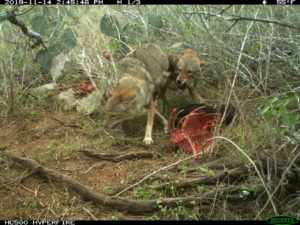 Carrion acts as an easily accessible and energetically low-cost nutrient source in the environment for variety of taxa including mammals, birds and insects. Through scavenging behavior, these animals provide benefits to the ecosystem and human populations by removing decaying animal matter from the environment. Coyotes- like many mammals- are facultative scavengers, and we are investigating factors influencing carrion use by coyotes, and how an influx of carrion deposits influences coyote movements and use of space.
Carrion acts as an easily accessible and energetically low-cost nutrient source in the environment for variety of taxa including mammals, birds and insects. Through scavenging behavior, these animals provide benefits to the ecosystem and human populations by removing decaying animal matter from the environment. Coyotes- like many mammals- are facultative scavengers, and we are investigating factors influencing carrion use by coyotes, and how an influx of carrion deposits influences coyote movements and use of space.